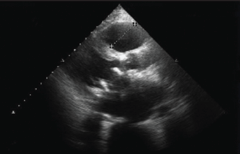The cardiovocal syndrome was first described by Otner, a Viennese physician, in 1897.1 It refers to a clinical syndrome of hoarseness due to dysfunction of the left recurrent laryngeal nerve, caused by cardiac diseases. Here, we describe a case of Otner’s syndrome following the second revision of mitral valve replacement.
Case report

A female patient was admitted to our unit after the second repair of her mitral valve, with breathlessness and hoarseness about 10 days after the operation. Prior to the last revision she was in left ventricular failure due to severe paravalvular mitral regurgitation and, despite severe pulmonary hypertension and dilated left atrium (figure 1), she did not have any vocal symptoms prior to the operation. Ear, nose and throat examination revealed left vocal cord palsy with normal pharynx and larynx. During her stay her voice steadily improved.
Discussion
Cases have been reported showing an improvement of voice hoarseness after repair of the leaking prosthetic valve.2 However, in our case, hoarseness occurred after the repair. Although hoarseness of voice is common after endotracheal intubations, it tends to occur in the immediate post-operative stage and should resolve within three to five days. In our case it started much later.
Slow compression of nerves might lead to a compensatory mechanism maintaining some function of the nerve until a late stage. We propose that the sudden change in the pressure on the nerve by the enlarged pulmonary artery and/or left atrium caused a temporary nerve dysfunction, probably due to some oedema of the myelin sheath with complete recovery afterwards.
The left recurrent laryngeal nerve branches off the left vagus nerve, as it crosses the arch of the aorta. Then it hooks around the ligamentum arteriosum medial to the arch and ascends in the groove between the trachea and oesophagus, to enter the larynx behind the cricoid cartilage. Not surprisingly, this long course around the aortic arch makes it more frequently involved than the right nerve in various pathologies. A unilateral lesion causes paralysis of the ipsilateral larynx and lower sphincter of the pharynx. The vocal cord becomes immobile and lies near the midline. The compensatory mechanism is so efficient that the voice may remain, or soon return to normal.
Conflict of interest
None declared.
References
- Otner N. Recuurens Lahmung bei Mitralstenose. Vienna: Klin Wechenschi 1897;10:753–5.
- Silvia ZM, Fermin LB, Manuel AV. Paralysis of left recurrent laryngeal nerve palsy secondary to mitral periprosthesis insufficiency. Rev Esp Cardiol 1997;50:902–03.
